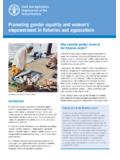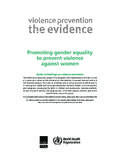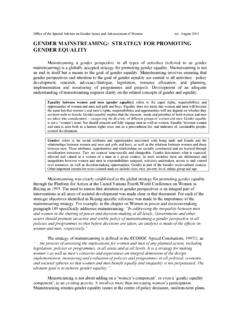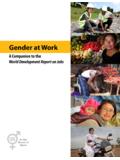Transcription of Enhancing Women’s Economic Empowerment …
1 Enhancing women s Economic Empowerment through Entrepreneurship and Business Leadership in OECD Countries Enhancing women S Economic Empowerment through ENTREPRENEURSHIP AND BUSINESS LEADERSHIP IN OECD COUNTRIES OECD 2014 5 FOREWORD Gender equality is both a moral and Economic imperative. Closing the gender gap must be a central part of any strategy to create more sustainable and inclusive economies and societies. It is about fairness and equity, the realisation of individual aspirations, Economic Empowerment around the world and growth. Greater educational attainment has accounted for about half of the Economic growth in OECD countries in the past 50 years and that owes a lot to bringing more girls to higher levels of education and achieving greater gender equality in educational attainment.
2 The OECD provides support for the gender policy agenda in different forms. It has been instrumental in putting the important role of gender equality for Economic growth on the G20 agenda (OECD et al., 2014), it supports gender equality and women s rights in the post-2015 development agenda, the OECD Development Centre monitors discriminatory social institutions around the world, it monitors progress in gender equality and relevant policy developments through a range of tools, publications and policy notes, including the OECD Gender Data Portal and special chapters in OECD Economic Surveys and a range of analytical publications.
3 This document reflects ongoing work on entrepreneurship within the OECD and was prepared as background paper for the China Development Research Foundation (CDRF) project on Enhancing women s Economic Empowerment through Entrepreneurship and Leadership in the Midst of China s New Urbanization. An initial draft was presented and discussed at the project s third workshop on 22 July 2014 in Beijing. This document provides a comprehensive overview and analysis based on global evidence to support the hypothesis that Enhancing women s Economic Empowerment by improving entrepreneurship and leadership could contribute to Economic growth, job creation and prosperity.
4 It includes policy analysis and best practices/solutions from OECD countries to support the main argument. This report was prepared by Willem Adema, Nabil Ali, Valerie Frey, Hyunsook Kim, Mariarosa Lunati, Mario Piacentini, and Monika Queisser. The OECD is solely responsible for the accuracy of the factual information provided in the report and for any of the views expressed therein. Enhancing women S Economic Empowerment through ENTREPRENEURSHIP AND BUSINESS LEADERSHIP IN OECD COUNTRIES OECD 2014 7 TABLE OF CONTENTS 1. Introduction and main findings .. 9 2. women in the labour market and entrepreneurship.
5 11 The leaky pipeline in employment participation .. 11 women remain under-represented among entrepreneurs and face different obstacles than men .. 14 3. The business case for better representation of women .. 17 Firms advancing women s Empowerment .. 20 Policies for better performing female-owned enterprises .. 21 Public policies to enhance the role of women in business leadership .. 24 References .. 29 Annex 1. The OECD gender recommendation and ilo conventions and recommendations on gender equality .. 36 Annex 2. Additional indicators on gender gaps in opportunities and labour market outcomes .. 39 Tables Annex Table Indicators on male and female labour market outcomes.
6 40 Annex Table Indicators of male and female educational attainment and performance .. 41 Figures Figure 1. The leaky pipeline: women are under-represented in senior management .. 12 Figure 2. OECD PISA Programme mean competency scores in reading, mathematics and science, by gender, 2012 .. 13 Figure 3. In many countries, the proportion of female entrepreneurs1 has not increased significantly .. 14 Figure 4. Men are more likely to prefer self-employment than women .. 15 Figure 5. Earnings gap in self-employment, 2014 .. 17 Annex Figure Proportion of the population who have an account with a formal financial institution and who received a loan from a formal financial institution, by sex, 2011.
7 42 Enhancing women S Economic Empowerment through ENTREPRENEURSHIP AND BUSINESS LEADERSHIP IN OECD COUNTRIES OECD 2014 9 Enhancing women S Economic Empowerment through ENTREPRENEURSHIP AND ENTREPRENEURSHIP IN OECD COUNTRIES 1. Introduction and main findings The case for gender equality is founded in both human rights and Economic arguments. As such, closing gender gaps must be a central part of any strategy to create more sustainable and inclusive economies and societies. In order to identify barriers to greater gender equality and build on its expertise in these areas, the OECD launched its Gender Initiative to help governments promote gender equality in Education, Employment and Entrepreneurship (Box 1).
8 Greater education participation, from an early age onwards, provides better Economic opportunities for women by raising the overall level of human capital and labour productivity. Mobilising hitherto underutilised labour supply and ensuring higher female employment will widen the base of taxpayers and contributors to social protection systems which will come under increasing pressure due to population ageing. More gender diversity will help promote innovation and competitiveness in business. Greater Economic Empowerment of women and greater gender equality in leadership are key components of the OECD s wider gender initiative to develop policies for stronger, better and fairer growth (OECD, 2011a and 2012).
9 Achieving greater gender equality remains a big challenge notwithstanding the important gains that have been made in women s education and employment outcomes in recent history. Most OECD countries have achieved gender parity in education attainment, but women remain severely under-represented in key, growth- Enhancing fields of education such as science, technology, engineering and mathematics. Labour markets exhibit many gender gaps . women are less likely to work for pay, and are more likely to have lower hourly earnings, do more unpaid housework than men and in general the gender gaps of disadvantage in the labour market are more pronounced in the Asia/Pacific region than across the OECD.
10 Given this backdrop, it is no surprise that women s position in business leadership and entrepreneurship needs to be strengthened. women remain under-represented as entrepreneurs. When asked, fewer women than men say they would prefer to be self-employed. When they do choose to become entrepreneurs, they cite better work-life balance more often than men as the main motivation for starting a business. As they frequently divide their time between working and caring women s businesses are usually on a smaller scale and in a limited range of sectors. They often have less experience when they start up a business and are also less likely than men to borrow money to finance their business.

















